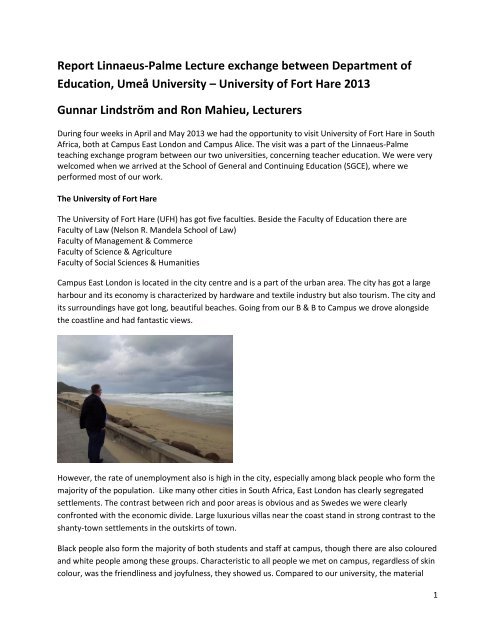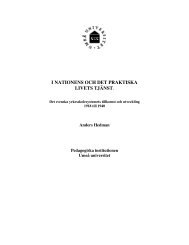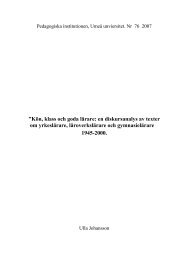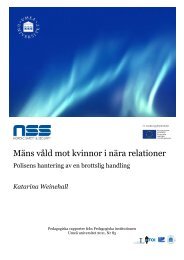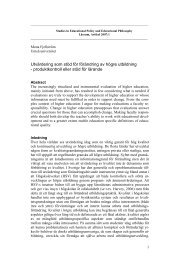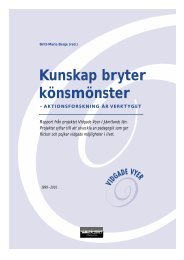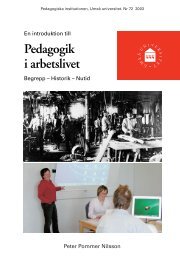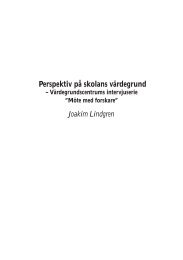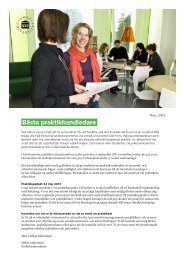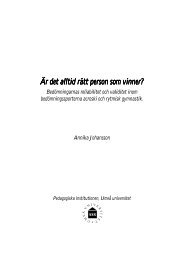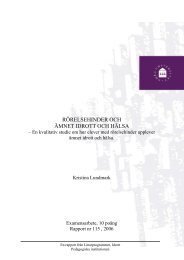University of Fort Hare 2013 Gunnar
University of Fort Hare 2013 Gunnar
University of Fort Hare 2013 Gunnar
You also want an ePaper? Increase the reach of your titles
YUMPU automatically turns print PDFs into web optimized ePapers that Google loves.
Report Linnaeus-Palme Lecture exchange between Department <strong>of</strong>Education, Umeå <strong>University</strong> – <strong>University</strong> <strong>of</strong> <strong>Fort</strong> <strong>Hare</strong> <strong>2013</strong><strong>Gunnar</strong> Lindström and Ron Mahieu, LecturersDuring four weeks in April and May <strong>2013</strong> we had the opportunity to visit <strong>University</strong> <strong>of</strong> <strong>Fort</strong> <strong>Hare</strong> in SouthAfrica, both at Campus East London and Campus Alice. The visit was a part <strong>of</strong> the Linnaeus-Palmeteaching exchange program between our two universities, concerning teacher education. We were verywelcomed when we arrived at the School <strong>of</strong> General and Continuing Education (SGCE), where weperformed most <strong>of</strong> our work.The <strong>University</strong> <strong>of</strong> <strong>Fort</strong> <strong>Hare</strong>The <strong>University</strong> <strong>of</strong> <strong>Fort</strong> <strong>Hare</strong> (UFH) has got five faculties. Beside the Faculty <strong>of</strong> Education there areFaculty <strong>of</strong> Law (Nelson R. Mandela School <strong>of</strong> Law)Faculty <strong>of</strong> Management & CommerceFaculty <strong>of</strong> Science & AgricultureFaculty <strong>of</strong> Social Sciences & HumanitiesCampus East London is located in the city centre and is a part <strong>of</strong> the urban area. The city has got a largeharbour and its economy is characterized by hardware and textile industry but also tourism. The city andits surroundings have got long, beautiful beaches. Going from our B & B to Campus we drove alongsidethe coastline and had fantastic views.However, the rate <strong>of</strong> unemployment also is high in the city, especially among black people who form themajority <strong>of</strong> the population. Like many other cities in South Africa, East London has clearly segregatedsettlements. The contrast between rich and poor areas is obvious and as Swedes we were clearlyconfronted with the economic divide. Large luxurious villas near the coast stand in strong contrast to theshanty-town settlements in the outskirts <strong>of</strong> town.Black people also form the majority <strong>of</strong> both students and staff at campus, though there are also colouredand white people among these groups. Characteristic to all people we met on campus, regardless <strong>of</strong> skincolour, was the friendliness and joyfulness, they showed us. Compared to our university, the material1
conditions differ at Campus East London. Teaching was held in large venues with poor acoustics and theteachers had to bring technological equipment to their lessons, i.e. projectors, microphone andloudspeakers. The student groups were big, <strong>of</strong>ten more than 50 persons, which complicated thedialogue between teachers and students, although it was not impossible. In relation to these conditions,we just have to admit, we are fortunate at Umeå <strong>University</strong>. During our stay in East London we receivedmuch help from Dr Greta Galloway, Head <strong>of</strong> School, who facilitated our schedules, meetings with facultymanagement, seminars etc. She and her husband also showed us great hospitality. “Tusen tack, Greta!”(Thousands <strong>of</strong> Thanks, Greta!)Campus Alice has got a beautiful outdoor environment - trees, flowers and a mix <strong>of</strong> old and modernbuildings in neat architecture. The National Heritage and Cultural Studies Centre is located at CampusAlice and it was very interesting to get a guided tour thru those collections by archivist Mark Snyders.Here there is also a big ANC- archive.Indoor environment and the size <strong>of</strong> student groups were similar to East London. Similar was also thefriendliness and commitment both students and staff showed to teacher education and towards us.During our stay in Alice we received a lot <strong>of</strong> help from Mrs Zelda Vye when it comes to schedules,computer equipment in our <strong>of</strong>fices, keys, c<strong>of</strong>fee, etc. Thank you very much Zelda!2
HogsbackWhile working at Alice campus we stayed in Hogsback, a little village 40 kilometres from campus, up inthe Mountains. It is a very beautiful place, with indigenous forests, streams and waterfalls. For swedes itis quite exotic seeing monkeys jumping through the trees outside the hotel. We also would like to thank MrMike Adendorf and Mrs Zelda Vye for their hospitality and for taking us to places with fantastic views.TeachingDuring our time at UFH we had a lot <strong>of</strong> lectures in different courses. <strong>Gunnar</strong>, for example, had coteaching/lecturestogether with Ms Florence Mudewu on the topic Inclusive education. It was interestingand rewarding planning the lectures with a Zimbabwean colleague and discus the topic with thestudents. Despite the fact that many students will do their future work in poor schools with very largegroups <strong>of</strong> pupils, they considered it important trying to meet and help pupils with special needs. Ron, forexample, had lessons about Bloom´s taxonomy and mastery learning.Another course in Foundation Phase in which we participate was “Life skills” on the topic Family andCommunity. <strong>Gunnar</strong> introduced a model for teaching in social sciences, called Aylamodellen. It is basedon discussing and structuring basic human needs and then applying it on different societies. It wasinteresting talking with students about both the model, teaching in social sciences and comparing howhuman needs are handled in South Africa and Sweden. It stood clear not only for <strong>Gunnar</strong>, but also for thestudents, that our basic needs and emotions unites us as humans, though we live under differentconditions.3
In Alice one <strong>of</strong> the teaching focuses was: Methods and Models in History Teaching: philosophicalfoundations <strong>of</strong> teaching methods i.e. assumption about teaching and learning. Also here <strong>Gunnar</strong>introduced some perspectives and models we use in Swedish history teaching, which the South Africanstudents then should apply on their national history 1900-<strong>2013</strong>. Also on this topic we had someinteresting discussions, but here we can see differences between South African and Swedish approach toHistory as a school subject. Undoubtedly, the students have good factual knowledge, but they are not soused to analyse historical processes from different perspectives. As their lecturer said: “Swedish historyteaching is more open ended”. Ron also had a lecture on entrepreneurship in education for the B ED2group <strong>of</strong> students. Entrepreneurship in education has become popular in South Africa as well and Rondiscussed the matter from a Swedish and an international perspective. Why are these trends happeningworld-wide?Back in East London <strong>Gunnar</strong> had lessons on the Topic: The Teaching Pr<strong>of</strong>ession – Being a Pr<strong>of</strong>essionalTeacher, where we discussed what constitutes a pr<strong>of</strong>ession in general and the teaching pr<strong>of</strong>ession inparticular. Which roles do science and proven experience play in teacher pr<strong>of</strong>ession? The students werequite clear in their answers, clearer than Swedish students <strong>Gunnar</strong> thinks. Ron had lessons in the topic:Schools, family and community and discussed the matter <strong>of</strong> the interrelationship between education andsociety. Ron also delivered a lecture at the Afrikaans Language Department. Topic: Lecturing inNederlands and the origin <strong>of</strong> the language. It was very interesting to talk in Dutch to the students whilethey responded in Afrikaans. Both Ron and the students learned many interesting aspects <strong>of</strong> language,similarities and differences.To illustrate our Swedish teacher background we had a joint presentation in Foundation Phace about TheSwedish Education System. Comparing and discussing similarities and differences between South Africaand Sweden, societies and school systems, were instructive not only for students but also for us, asteachers. We have more in common than we think when it comes to issues as school start, schoolsubjects, compulsory school years, political intentions with education, etc. The differences lie primarily insocial structures, in the political system and economic distribution among different social groups,conditions that have a major impact on i.e. level <strong>of</strong> education among the population in our twocountries.We also had a joint presentation in a PGCE - group on the topic Kohlberg's theory <strong>of</strong> moral development,followed by discussions in smaller and bigger groups – interesting.SeminarsBesides teaching we had some joint seminars with colleagues both in Alice Campus and in East LondonCampus. The topics were, for example:Teacher Education- Global Trends from a Swedish perspective. The impact that globalisation puton education.Teacher Educator, Identity and Student assessment.The process <strong>of</strong> developing a literature review chapter.4
Seminars with colleagues are always rewarding, especially when you get new perspectives upon an issue,i.e. from another country with other cultures and history.Other meetingsBesides teaching and seminars we had several other meetings with colleagues around different issues,e.g.:Discussing with Director Arthur Johnson at the International Department about possibilities for acollaboration project in ICT and learningResearch discussion with Drs Duku and Sotuku about possibilities <strong>of</strong> a comparative study onteacher education between UFH and UMU.Lunch and Dinner at the Faculty with Dean Dr Xoliswa, Pr<strong>of</strong>. George Moyo, Dr. Greta Galloway,Dr Stunky Duku, and other guests. Nice meetings both for Body and Soul! Thank You all!Swedish exchange studentsThe two Swedish exchange students Hanna Olsson and Hanna Notsten did their school practice duringour time in East London so we visit them twice at Sterling High School, followed their teaching and hadsome tutoring conversation after the lesson. We also had a final talk with the school`s principal whichgave us opportunities to discuss the school system in both South Africa and Sweden.Personal reflections<strong>Gunnar</strong>. South Africa is such a beautiful country! The nature <strong>of</strong> Eastern Cape is fantastic. After theworking period at UFH, my wife, our youngest daughter and I had a week <strong>of</strong> vacation in Cape Town andits surroundings. What amazing places we saw!!5
I am happy and grateful that I got the opportunity to go to South Africa and UFH. I have met interestingand wonderful people dedicated in their work, learnt a lot about education and society life in SA andthrough that also learnt more about my own country, our school system, our teacher education, etc. SAfaces major challenges, poverty, criminality, but has also overcome large problems, i.e. politicalrepression during the apartheid regime. After visiting Robben Island, knowing how Mandela and otherpolitical leaders left their prison with democracy in minds, not revenge - there must be hope for thefuture!The bus on Robben IslandRon. Already during my first visit to South Africa, I had fallen in love with the country and its people. Eventhough it was my second time as an exchange lecturer at <strong>Fort</strong> <strong>Hare</strong>, I enjoyed it even more and I learnedmany new things. That is maybe the advantage <strong>of</strong> travelling to a place more than one time; you start tolearn from another perspective and appreciate things even more. It was certainly also helpful to havemet staff before, and therefor to be aware <strong>of</strong> certain routines and customs. Several staff members havebecome friends, <strong>of</strong> which some even good friends. Although it was not the major aim, the exchange hasalso generated small co-operative research projects on which we now currently are working, which is anexample <strong>of</strong> one <strong>of</strong> the many positive side-effects <strong>of</strong> staff from two universities that meet. The exchangehas added value in so many ways. To see conditions in another country also gives some perspectives onthe home country. Hopefully I will be able to return to the country and to <strong>Fort</strong> <strong>Hare</strong> in East London,several times in the future.Ron Mahieu & <strong>Gunnar</strong> Lindström, Umeå <strong>University</strong>.6


